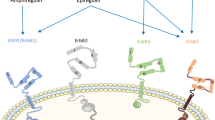Abstract
Retinoblastoma protein (pRb) phosphorylation plays a central role in mediating cell cycle G1/S stage transition, together with E2F transcription factors. The binding of pRb to E2F is thought to be controlled by the sequential and cumulative phosphorylation of pRb at various amino acids. In addition to well characterized roles as a tumor suppressor, pRb has more recently been implicated in osteoprogenitor and other types of stem cell maintenance, proliferation and differentiation, thereby influencing the morphogenesis of developing organs. In this study, we present data characterizing the expression of pRb and three phosphorylated pRb (ppRb) isoforms—ppRbS780, ppRbS795, ppRbS807/811—in developmentally staged mouse molar and incisor teeth. Our results reveal distinct developmental expression patterns for individual ppRb isoforms in dental epithelial and dental mesenchymal cell differentiation, suggesting discrete functions in tooth development.





Similar content being viewed by others
References
Andreeva et al (2012) Rb1 mRNA expression in developing mouse teeth. Gene Expr Patterns. doi:10.1016/j.gep.2012.01.004
Boylan JF, Sharp DM et al (1999) Analysis of site-specific phosphorylation of the retinoblastoma protein during cell cycle progression. Exp Cell Res 248(1):110–114
Brown VD, Phillips RA et al (1999) Cumulative effect of phosphorylation of pRB on regulation of E2F activity. Mol Cell Biol 19(5):3246–3256
Brugarolas J, Moberg K et al (1999) Inhibition of cyclin-dependent kinase 2 by p21 is necessary for retinoblastoma protein-mediated G1 arrest after gamma-irradiation. Proc Natl Acad Sci USA 96(3):1002–1007
Clarke AR, Maandag ER et al (1992) Requirement for a functional Rb-1 gene in murine development. Nature 359(6393):328–330
Cobrinik D (2005) Pocket proteins and cell cycle control. Oncogene 24(17):2796–2809
DeCaprio JA, Ludlow JW et al (1989) The product of the retinoblastoma susceptibility gene has properties of a cell cycle regulatory element. Cell 58(6):1085–1095
Dunn JM, Phillips RA et al (1988) Identification of germline and somatic mutations affecting the retinoblastoma gene. Science 241(4874):1797–1800
Endicott JA, Noble ME et al (1999) Cyclin-dependent kinases: inhibition and substrate recognition. Curr Opin Struct Biol 9(6):738–744
Ezhevsky SA, Ho A et al (2001) Differential regulation of retinoblastoma tumor suppressor protein by G(1) cyclin-dependent kinase complexes in vivo. Mol Cell Biol 21(14):4773–4784
Ferguson KL, McClellan KA et al (2005) A cell-autonomous requirement for the cell cycle regulatory protein, Rb, in neuronal migration. EMBO J 24(24):4381–4391
Gutierrez GM, Kong E et al (2008) Impaired bone development and increased mesenchymal progenitor cells in calvaria of RB1-/- mice. Proc Natl Acad Sci USA 105(47):18402–18407
Harada H, Kettunen P et al (1999) Localization of putative stem cells in dental epithelium and their association with Notch and FGF signaling. J Cell Biol 147(1):105–120
Hudson R, Taniguchi-Sidle A et al (1998) Alx-4, a transcriptional activator whose expression is restricted to sites of epithelial-mesenchymal interactions. Dev Dyn 213(2):159–169
Jordan-Sciutto KL, Wang G et al (2000) Induction of cell-cycle regulators in simian immunodeficiency virus encephalitis. Am J Pathol 157(2):497–507
Kitagawa M, Higashi H et al (1996) The consensus motif for phosphorylation by cyclin D1-Cdk4 is different from that for phosphorylation by cyclin A/E-Cdk2. EMBO J 15(24):7060–7069
Knudsen ES, Wang JY (1996) Differential regulation of retinoblastoma protein function by specific Cdk phosphorylation sites. J Biol Chem 271(14):8313–8320
Knudsen ES, Wang JY (1997) Dual mechanisms for the inhibition of E2F binding to RB by cyclin-dependent kinase-mediated RB phosphorylation. Mol Cell Biol 17(10):5771–5783
Kumamoto H, Kimi K et al (2001) Detection of cell cycle-related factors in ameloblastomas. J Oral Pathol Med 30(5):309–315
Kumamoto H, Ooya K (2006) Immunohistochemical detection of retinoblastoma protein and E2 promoter-binding factor-1 in ameloblastomas. J Oral Pathol Med 35(3):183–189
Lee EY, To H et al (1988) Inactivation of the retinoblastoma susceptibility gene in human breast cancers. Science 241(4862):218–221
Meyerson M, Harlow E (1994) Identification of G1 kinase activity for cdk6, a novel cyclin D partner. Mol Cell Biol 14(3):2077–2086
Mittnacht S (1998) Control of pRB phosphorylation. Curr Opin Genet Dev 8(1):21–27
Mittnacht S, Weinberg RA (1991) G1/S phosphorylation of the retinoblastoma protein is associated with an altered affinity for the nuclear compartment. Cell 65(3):381–393
Mittnacht S, Lees JA et al (1994) Distinct sub-populations of the retinoblastoma protein show a distinct pattern of phosphorylation. EMBO J 13(1):118–127
Pande P, Mathur M et al (1998) pRb and p16 protein alterations in human oral tumorigenesis. Oral Oncol 34(5):396–403
Poznic M (2009) Retinoblastoma protein: a central processing unit. J Biosci 34(2):305–312
Ruiz S, Segrelles C et al (2003) Abnormal epidermal differentiation and impaired epithelial-mesenchymal tissue interactions in mice lacking the retinoblastoma relatives p107 and p130. Development 130(11):2341–2353
Sosa-Garcia B, Gunduz V et al (2010) A role for the retinoblastoma protein as a regulator of mouse osteoblast cell adhesion: implications for osteogenesis and osteosarcoma formation. PLoS One 5(11):e13954
Takaki T, Fukasawa K et al (2005) Preferences for phosphorylation sites in the retinoblastoma protein of D-type cyclin-dependent kinases, Cdk4 and Cdk6, in vitro. J Biochem 137(3):381–386
Thakur A, Siedlak SL et al (2008) Retinoblastoma protein phosphorylation at multiple sites is associated with neurofibrillary pathology in Alzheimer disease. Int J Clin Exp Pathol 1(2):134–146
Weinberg RA (1995) The retinoblastoma protein and cell cycle control. Cell 81(3):323–330
Wiggan O, Taniguchi-Sidle A et al (1998) Interaction of the pRB-family proteins with factors containing paired-like homeodomains. Oncogene 16(2):227–236
Zarkowska T, Mittnacht S (1997) Differential phosphorylation of the retinoblastoma protein by G1/S cyclin-dependent kinases. J Biol Chem 272(19):12738–12746
Acknowledgments
The authors would like to thank the Yelick and Hinds Laboratory members for support and expert advice.
Conflict of interest
We acknowledge that there are no perceived or actual conflicts of interest to disclose, and support from ARRA funded NIH/NIDCR grant DE016962 (PCY).
Author information
Authors and Affiliations
Corresponding author
Rights and permissions
About this article
Cite this article
Zhang, W., Vazquez, B., Andreeva, V. et al. Discrete phosphorylated retinoblastoma protein isoform expression in mouse tooth development. J Mol Hist 43, 281–288 (2012). https://doi.org/10.1007/s10735-012-9404-4
Received:
Accepted:
Published:
Issue Date:
DOI: https://doi.org/10.1007/s10735-012-9404-4




